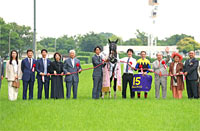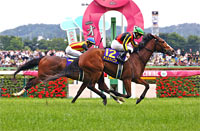2015 News
Data Analysis for the “2015 Yushun Himba (Japanese Oaks) (G1)”Second fillies' classic contested over 2,400m The year’s second classic race for fillies is the Yushun Himba, held on the 2,400m turf course at Tokyo. The distance of 2,400m is unknown territory for most of the runners, so they’ll need to summon up all their skill for a chance of victory. The fact that many Oaks winners over the last few years have enjoyed success in subsequent G1 racing seems to prove as much. This time, let’s check trends in this race based on results over the last 10 years. Favored horses dominate Viewing the runners’ aggregate performances over the last 10 years by favoritism to win, the more highly favored horses basically dominate, though the top 2 ratios of 50.0% and 40.0% for the 1st and 2nd favorites are not particularly spectacular. Turning next to the performance by win odds, horses supported by multiples of “1.9 or lower” have a perfect top 2 ratio of 100%, but those with “2.0-3.9” and “4.0-6.9” are less impressive. On the other hand, horses with multiples of “7.0-9.9” have success ratios second only to the “1.9 or lower” group. Also worth noting is that seven fillies with odds multiples of “10.0-49.9” have finished 3rd in this race. [Table 1] [Table 2] [Table 1] Performance by favoritism to win (last 10 years)
* Dead heat for 1st place in 2010. [Table 2] Performance by win odds (last 10 years)
* Dead heat for 1st place in 2010. Oka Sho is the best bet as the “previous race” On aggregating performances based on the runners’ previous race, we find that 14 of the 20 top 2 finishers over the last 10 years had most recently contested the “Oka Sho (Japanese 1000 Guineas)”. Of the others, the “Flora Stakes” has produced eight top 3 finishers but only one winner – Saint Emilion in 2010 (dead heat for 1st with Apapane). The “Sweet Pea Stakes” and “Wasurenagusa Sho” have each produced one winner, but seen overall, the “Oka Sho” yields by far the greatest success. [Table 3] [Table 3] Performance by previous race (last 10 years)
* Dead heat for 1st place in 2010. Next, if we take the 76 horses most recently seen in the “Oka Sho” and check performances in the Oaks in terms of their finish in the Oka Sho, we find that, of 18 top 3 finishers here, 15 had achieved a top 4 finish in the Oka Sho. In terms of success ratios, too, fillies with a “top 4” finish in the Oka Sho have far outperformed those finishing “5th or lower”. It appears that the better the finish in the Oka Sho, the more successful the performance here. [Table 4] [Table 4] Performance by finish in the Oka Sho when it was the previous race (last 10 years)
* Dead heat for 1st place in 2010. Check for runners finishing 2nd and 3rd in graded races In each of the last 10 years except 2007, a horse that had “finished 2nd or 3rd in a graded race since March that year” has taken a top 2 place in the Japanese Oaks. If any of this year’s runners has a similar record in graded races since March, it might be interesting to take note. [Table 5] [Table 5] Top 2 finishers with experience of finishing 2nd or 3rd in a graded race since March that year (last 10 years)
* Dead heat for 1st place in 2010. Seek out the winners! The last 5 winners of the Oaks had experienced “victory as 2nd favorite within their previous 3 outings” (not including Saint Emilion, joint winner in 2010 after a dead heat with Apapane). If any of this year’s runners come with that kind of track record, a mark on the card would be heartily recommended. [Table 6] [Table 6] Check for experience of victory as 2nd favorite within the last 3 outings (last 5 years)
* Not including Saint Emilion, joint winner in 2010 after a dead heat with Apapane. (Data analysis by Yasunori Asano) |

|
|||||||||||||||||||||||||||||||||||||||||||||||||||||||||||||||||||||||||||||||||||||||||||||||||||||||||||||||||||||||||||||||||||||||||||||||||||||||||||||||||||||||||||||||||||||||||||||||||||||||||||||||||||||||||||||||||||||||



















